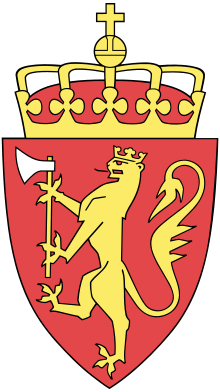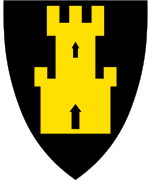Karasjok
Kárášjohka (Northern Sami)[3] or ![]()
Karasjok kommune Kárašjoga gielda Kaarasjoki | |
|---|---|
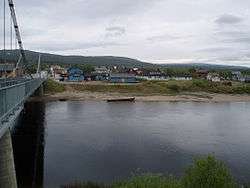 | |
 Flag 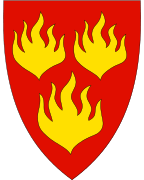 Coat of arms 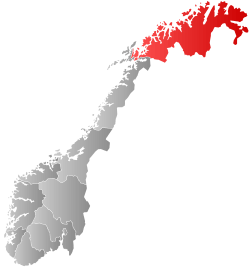 Troms og Finnmark within Norway | |
 Karasjok within Troms og Finnmark | |
| Coordinates: 69°28′55″N 25°06′18″E | |
| Country | Norway |
| County | Troms og Finnmark |
| Established | 1 Jan 1866 |
| Administrative centre | Karasjok |
| Government | |
| • Mayor (2015) | Svein Atle Somby (Ap) |
| Area | |
| • Total | 5,452.95 km2 (2,105.40 sq mi) |
| • Land | 5,209.46 km2 (2,011.38 sq mi) |
| • Water | 243.49 km2 (94.01 sq mi) 4.5% |
| Area rank | 2 in Norway |
| Population (2020) | |
| • Total | 2,628 |
| • Rank | 245 in Norway |
| • Density | 0.5/km2 (1/sq mi) |
| • Change (10 years) | −5.8% |
| Demonym(s) | Karasjoking[1] |
| Time zone | UTC+01:00 (CET) |
| • Summer (DST) | UTC+02:00 (CEST) |
| ISO 3166 code | NO-5437 |
| Official language form | Bokmål and Northern Sami[2] |
| Website | karasjok |
The 5,453-square-kilometre (2,105 sq mi) municipality is the second largest by area out of the 356 municipalities in Norway. Karasjok is the 245th most populous municipality in Norway with a population of 2,628. The municipality's population density is 0.5 inhabitants per square kilometre (1.3/sq mi) and its population has decreased by 5.8% over the last decade.[4][5]
General information
The municipality of Karasjok was established on 1 January 1866 when it was separated from the old Kistrand municipality. Initially, the population of Karasjok was 515. The municipal borders have not changed since that time.[6]
On 1 January 2020, the municipality became part of the newly formed Troms og Finnmark county. Previously, it had been part of the old Finnmark county.[7]
Name
Karasjok is a Norwegianized form of the Northern Sami language name Kárášjohka. The meaning of the first element could be káráš from Northern Sami which could mean "food plate of wood", or from Finnish, kara, "something that sticks". The last element is johka which means "river",[8] whose equivalent in Finnish is joki.
The name of the municipality was Karasjok until 1990 when it was changed to Kárášjohka-Karasjok.[9] It was the third municipality in Norway to get a Sami name. In 2005, the name was again changed, such that either Kárášjohka or Karasjok can be used.[10]
Coat of arms
The coat of arms is from modern times; they were granted on 27 June 1986. The three gold-colored flames on a red background. The flames were chosen as a symbol for the importance of fire to the local (nomadic) Sami people. The fire brings both heat and thus survival during the harsh winters, but it is also a major threat, both in the tents as well as in the large pine forests. The fire is also the point around which people gather and it is a guard against dangers. The flag contains three flames also because Kárásjoga-Karasjok is a place where three peoples live: the Sami, Norwegians, and Kvens.[11]
Churches
The Church of Norway has one parish (sokn) within the municipality of Karasjok. It is part of the Indre Finnmark prosti (deanery) in the Diocese of Nord-Hålogaland.
| Parish (Sokn) | Church Name | Location of the Church | Year Built |
|---|---|---|---|
| Karasjok | Karasjok Church | Karasjok | 1974 |
| Old Karasjok Church | Karasjok | 1807 | |
| Suosjavrre Chapel | Šuoššjávri | 1968 | |
| Valjok Church | Váljohka | 1932 |
Transportation
There is an official border crossing between Dorvonjárga (Norway) and Karigasniemi (Finland), over the Anarjohka river. The European route E6 highway passes through the municipality from Lakselv to Tana bru and Kirkenes in the east. The nearest airport is Lakselv Airport, about 80 kilometres (50 mi) from Karasjok village.
Government
All municipalities in Norway, including Karasjok, are responsible for primary education (through 10th grade), outpatient health services, senior citizen services, unemployment and other social services, zoning, economic development, and municipal roads. The municipality is governed by a municipal council of elected representatives, which in turn elect a mayor.[12] The municipality falls under the Indre Finnmark District Court and the Hålogaland Court of Appeal.
Municipal council
The municipal council (Kommunestyre) of Karasjok is made up of 19 representatives that are elected to four year terms. The party breakdown of the council is as follows:
| Party Name (in Norwegian) | Number of representatives | |
|---|---|---|
| Labour Party (Arbeiderpartiet) | 7 | |
| Conservative Party (Høyre) | 1 | |
| Sámi People's Party (Samefolkets Parti) | 2 | |
| Centre Party (Senterpartiet) | 6 | |
| Karasjok List (Karasjok lista) | 2 | |
| Johttiidsámiid List (Johttiidsámiid listu) | 1 | |
| Total number of members: | 19 | |
| Party Name (in Norwegian) | Number of representatives | |
|---|---|---|
| Labour Party (Arbeiderpartiet) | 7 | |
| Conservative Party (Høyre) | 1 | |
| Christian Democratic Party (Kristelig Folkeparti) | 1 | |
| Sámi People's Party (Samefolkets Parti) | 2 | |
| Centre Party (Senterpartiet) | 6 | |
| Karasjok List (Karasjok lista) | 2 | |
| Johttiidsámiid List (Johttiidsámiid listu) | 1 | |
| Total number of members: | 19 | |
| Party Name (in Norwegian) | Number of representatives | |
|---|---|---|
| Labour Party (Arbeiderpartiet) | 4 | |
| Conservative Party (Høyre) | 1 | |
| Sámi People's Party (Samefolkets Parti) | 2 | |
| Centre Party (Senterpartiet) | 5 | |
| Liberal Party (Venstre) | 2 | |
| Árja (Árja) | 1 | |
| Karasjok List (Karasjok lista) | 3 | |
| Johttiidsámiid List (Johttiidsámiid listu) | 1 | |
| Total number of members: | 19 | |
| Party Name (in Norwegian) | Number of representatives | |
|---|---|---|
| Labour Party (Arbeiderpartiet) | 7 | |
| Christian Democratic Party (Kristelig Folkeparti) | 1 | |
| Sámi People's Party (Samefolkets Parti) | 4 | |
| Centre Party (Senterpartiet) | 3 | |
| Liberal Party (Venstre) | 1 | |
| Socialist Group (Sosialisttalas joavku/Sosialistisk gruppe) | 1 | |
| Karasjok Travelling Sámi List (Karasjok flyttsamelagets liste) | 2 | |
| Total number of members: | 19 | |
| Party Name (in Norwegian) | Number of representatives | |
|---|---|---|
| Labour Party (Arbeiderpartiet) | 8 | |
| Christian Democratic Party (Kristelig Folkeparti) | 1 | |
| Sámi People's Party (Samefolkets Parti) | 4 | |
| Centre Party (Senterpartiet) | 2 | |
| Liberal Party (Venstre) | 1 | |
| Socialist Group (Sosialisttalas joavku/Sosialistisk gruppe) | 1 | |
| Karasjok Travelling Sámi List (Karasjok flyttsamelagets liste) | 2 | |
| Total number of members: | 19 | |
| Party Name (in Norwegian) | Number of representatives | |
|---|---|---|
| Labour Party (Arbeiderpartiet) | 8 | |
| Christian Democratic Party (Kristelig Folkeparti) | 2 | |
| Sámi People's Party (Samefolkets Parti) | 6 | |
| Centre Party (Senterpartiet) | 1 | |
| Liberal Party (Venstre) | 1 | |
| Socialist Group (Sosialistisk gruppe) | 1 | |
| Total number of members: | 19 | |
| Party Name (in Norwegian) | Number of representatives | |
|---|---|---|
| Labour Party (Arbeiderpartiet) | 9 | |
| Conservative Party (Høyre) | 1 | |
| Christian Democratic Party (Kristelig Folkeparti) | 1 | |
| Centre Party (Senterpartiet) | 2 | |
| Socialist Left Party (Sosialistisk Venstreparti) | 2 | |
| Sámi List (Sámeálbmot lista/Samefolkets list) | 4 | |
| Total number of members: | 19 | |
| Party Name (in Norwegian) | Number of representatives | |
|---|---|---|
| Labour Party (Arbeiderpartiet) | 7 | |
| Conservative Party (Høyre) | 1 | |
| Christian Democratic Party (Kristelig Folkeparti) | 2 | |
| Socialist Left Party (Sosialistisk Venstreparti) | 3 | |
| Sámi List (Sámeálbmot lista/Samefolkets list) | 3 | |
| Women's List in Karasjok (Kárásjoga nissonolbmuid lista/Kvinnelista i Karasjok) | 2 | |
| People's List in Karasjok (Kárásjoga albmotlista/Folkelista i Karasjok) | 1 | |
| Total number of members: | 19 | |
| Party Name (in Norwegian) | Number of representatives | |
|---|---|---|
| Labour Party (Arbeiderpartiet) | 9 | |
| Conservative Party (Høyre) | 1 | |
| Christian Democratic Party (Kristelig Folkeparti) | 1 | |
| Centre Party (Senterpartiet) | 1 | |
| Sámi List (Sámeálbmot lista/Samefolkets list) | 6 | |
| Karasjok Travelling Sámi List (Karasjok Flyttsameliste) | 1 | |
| Total number of members: | 19 | |
| Party Name (in Norwegian) | Number of representatives | |
|---|---|---|
| Labour Party (Arbeiderpartiet) | 10 | |
| Conservative Party (Høyre) | 2 | |
| Christian Democratic Party (Kristelig Folkeparti) | 1 | |
| Local Sámi List (Dalu-ja jåhttisamiid lista) | 6 | |
| Total number of members: | 19 | |
| Party Name (in Norwegian) | Number of representatives | |
|---|---|---|
| Labour Party (Arbeiderpartiet) | 8 | |
| Conservative Party (Høyre) | 3 | |
| Christian Democratic Party (Kristelig Folkeparti) | 1 | |
| Centre Party (Senterpartiet) | 1 | |
| Local Sámi List (Dalu-ja jåhttisamiid lista) | 6 | |
| Total number of members: | 19 | |
| Party Name (in Norwegian) | Number of representatives | |
|---|---|---|
| Labour Party (Arbeiderpartiet) | 9 | |
| Conservative Party (Høyre) | 2 | |
| Christian Democratic Party (Kristelig Folkeparti) | 1 | |
| Centre Party (Senterpartiet) | 1 | |
| Local Sámi List (Dalu-ja jåhttisamiid lista) | 5 | |
| Sámi List (Samefolkets liste) | 1 | |
| Total number of members: | 19 | |
| Party Name (in Norwegian) | Number of representatives | |
|---|---|---|
| Labour Party (Arbeiderpartiet) | 8 | |
| Conservative Party (Høyre) | 2 | |
| Centre Party (Senterpartiet) | 3 | |
| Liberal Party (Venstre) | 1 | |
| Local List(s) (Lokale lister) | 8 | |
| Total number of members: | 19 | |
| Party Name (in Norwegian) | Number of representatives | |
|---|---|---|
| Labour Party (Arbeiderpartiet) | 8 | |
| Conservative Party (Høyre) | 2 | |
| Centre Party (Senterpartiet) | 2 | |
| Liberal Party (Venstre) | 2 | |
| Local List(s) (Lokale lister) | 1 | |
| Total number of members: | 15 | |
| Party Name (in Norwegian) | Number of representatives | |
|---|---|---|
| Labour Party (Arbeiderpartiet) | 7 | |
| Conservative Party (Høyre) | 2 | |
| List of workers, fishermen, and small farmholders (Arbeidere, fiskere, småbrukere liste) | 3 | |
| Local List(s) (Lokale lister) | 3 | |
| Total number of members: | 15 | |
| Party Name (in Norwegian) | Number of representatives | |
|---|---|---|
| Labour Party (Arbeiderpartiet) | 7 | |
| Conservative Party (Høyre) | 1 | |
| List of workers, fishermen, and small farmholders (Arbeidere, fiskere, småbrukere liste) | 5 | |
| Local List(s) (Lokale lister) | 2 | |
| Total number of members: | 15 | |
| Party Name (in Norwegian) | Number of representatives | |
|---|---|---|
| Labour Party (Arbeiderpartiet) | 7 | |
| List of workers, fishermen, and small farmholders (Arbeidere, fiskere, småbrukere liste) | 4 | |
| Joint List(s) of Non-Socialist Parties (Borgerlige Felleslister) | 3 | |
| Local List(s) (Lokale lister) | 1 | |
| Total number of members: | 15 | |
| Party Name (in Norwegian) | Number of representatives | |
|---|---|---|
| Labour Party (Arbeiderpartiet) | 7 | |
| Liberal Party (Venstre) | 2 | |
| Joint List(s) of Non-Socialist Parties (Borgerlige Felleslister) | 1 | |
| Local List(s) (Lokale lister) | 2 | |
| Total number of members: | 12 | |
| Party Name (in Norwegian) | Number of representatives | |
|---|---|---|
| Labour Party (Arbeiderpartiet) | 9 | |
| Local List(s) (Lokale lister) | 3 | |
| Total number of members: | 12 | |
| Party Name (in Norwegian) | Number of representatives | |
|---|---|---|
| Labour Party (Arbeiderpartiet) | 7 | |
| List of workers, fishermen, and small farmholders (Arbeidere, fiskere, småbrukere liste) | 5 | |
| Total number of members: | 12 | |
| Party Name (in Norwegian) | Number of representatives | |
|---|---|---|
| Labour Party (Arbeiderpartiet) | 8 | |
| Local List(s) (Lokale lister) | 4 | |
| Total number of members: | 12 | |
Geography
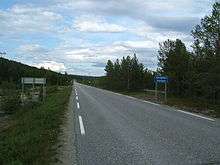
The municipality is situated along the upper river basin of the Deatnu / Tana river and its tributaries: Anárjohka and Kárášjohka. It includes large tracts of the high Finnmarksvidda plateau. Lakes in the region include Čorotjávri, Gásadatjávri, Iešjávri, and Idjajávri. The river valley, unlike the plateau, is covered with pine and birch forests. The southern part of the municipality is part of the Øvre Anárjohka National Park.
Climate
| Karasjok | ||||||||||||||||||||||||||||||||||||||||||||||||||||||||||||
|---|---|---|---|---|---|---|---|---|---|---|---|---|---|---|---|---|---|---|---|---|---|---|---|---|---|---|---|---|---|---|---|---|---|---|---|---|---|---|---|---|---|---|---|---|---|---|---|---|---|---|---|---|---|---|---|---|---|---|---|---|
| Climate chart (explanation) | ||||||||||||||||||||||||||||||||||||||||||||||||||||||||||||
| ||||||||||||||||||||||||||||||||||||||||||||||||||||||||||||
| ||||||||||||||||||||||||||||||||||||||||||||||||||||||||||||
In this far northeastern part of Norway, the climate is much more continental and dry compared to the typical coastal climate in Norway.
Situated in a river valley on this plateau, Karasjok has recorded the coldest official temperature ever in Norway: −51.4 °C (−60.5 °F) on 1 January 1886. The warmest temperature ever recorded in the summer is 32.4 °C (90.3 °F). In January 1999, there was also a cold shock, the "official" temperature recording was −51.2 °C (−60.2 °F), but unofficially a temperature of −56 °C (−68.8 °F) was recorded. The warmest month on record was July 1941, with a mean (24hr) temperature of 17.9 °C (64.2 °F); the coldest month was February 1966 with a mean of −27.1 °C (−16.8 °F).
Birdlife
The birdlife to be found in this municipality is characteristic for the region. The inland habitats of Finnmarksvidda are known for their rich bird life with species like Bluethroat preferring areas with scrub. The Tana river also flows through Karasjok and many of the species found in higher areas use it as a migration route.
Economy
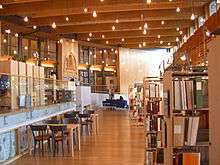
Most people live in the village of Karasjok (Kárášjohka). The village is the seat of the Sámediggi, the Sami Parliament of Norway, as well as of the Sami broadcasting, and several Sami institutions (public and private) are found here, including Davvi Girji, the largest Sámi publisher. About 80% of the population is Sami speaking, and Sami and Norwegian have equal status in the municipality.
Tourism
The attractions include the Sami parliament, Samediggi, the Sami museum, and the Old Karasjok Church, dating from 1807. The Sami parliament was opened in 1989, by King Olav V, the first Sami parliament president was Ole Henrik Magga, from Kautokeino. He was the president for more than eight years. The Old Karasjok Church is the oldest Lutheran church in Finnmark county. The church is today too small, so a new, larger, wooden Karasjok Church, inspired by Sami architecture, has been built. Karasjok is also the place to look for duodji, Sami handicraft.
Notable people
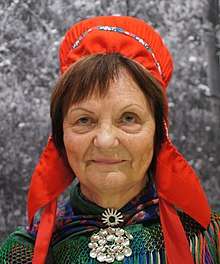
- Samuel Balto (1861 in Karasjok – 1921) a Norwegian–Sami explorer and adventurer in Alaska, Greenland and Canada
- Matti Aikio (1872 in Karasjok - 1929) a Norwegian Sami writer
- Iver Jåks (1932 in Karasjok – 2007) a Norwegian Sami artist, used Sami culture and mythology in his artistic works
- Inga Ravna Eira (1948 in Karasjok) a Norwegian Northern Sami language poet, children's writer, translator and schoolteacher
- Mari Boine (born 1956 in Gámehisnjárga) a Norwegian singer
- Tor Mikkel Wara (born 1964 in Karasjok) a Norwegian former politician
- Ragnhild Vassvik Kalstad (born 1966) politician, former member of Karasjok municipal council
- Susanne Guttorm (born 1996 in Karasjok) a Norwegian model and Miss Norway 2018
Sport
- Jan Egil Brekke (born 1974) a Norwegian footballer, grew up in Karasjok
- Leif Arne Brekke (born 1977) a Norwegian footballer, grew up in Karasjok
- Hans Norbye (born 1987 in Karasjok) a Norwegian footballer
References
- "Navn på steder og personer: Innbyggjarnamn" (in Norwegian). Språkrådet.
- "Forskrift om målvedtak i kommunar og fylkeskommunar" (in Norwegian). Lovdata.no.
- "Stadnamn og rettskriving" (in Norwegian). Kartverket. Retrieved 13 July 2018.
- Statistisk sentralbyrå (2020). "Table: 06913: Population 1 January and population changes during the calendar year (M)" (in Norwegian).
- Statistisk sentralbyrå (2020). "09280: Area of land and fresh water (km²) (M)" (in Norwegian).
- Jukvam, Dag (1999). "Historisk oversikt over endringer i kommune- og fylkesinndelingen" (PDF) (in Norwegian). Statistisk sentralbyrå.
- Mæhlum, Lars, ed. (24 December 2019). "Troms og Finnmark". Store norske leksikon (in Norwegian). Kunnskapsforlaget. Retrieved 26 December 2019.
- Store norske leksikon. "Kárášjohka/Karasjok" (in Norwegian). Retrieved 31 March 2013.
- "Ot.prp. nr. 111 (2001-2002)" (in Norwegian). Regjeringen.no.
- "Endring av skrivemåten for tospråklige kommuner. Endring av skrivemåten for tospråklige kommunenavn, Kárášjohka-Karasjok" (in Norwegian).
- "Civic heraldry of Norway - Norske Kommunevåpen". Heraldry of the World. Retrieved 5 June 2018.
- Hansen, Tore, ed. (12 May 2016). "kommunestyre". Store norske leksikon (in Norwegian). Kunnskapsforlaget. Retrieved 5 June 2018.
- "Tall for Norge: Kommunestyrevalg 2019 - Troms og Finnmark". Valg Direktoratet. Retrieved 20 October 2019.
- "Table: 04813: Members of the local councils, by party/electoral list at the Municipal Council election (M)" (in Norwegian). Statistics Norway.
- "Tall for Norge: Kommunestyrevalg 2011 - Finnmark". Valg Direktoratet. Retrieved 21 October 2019.
- "Kommunestyrevalget 1995" (PDF) (in Norwegian). Oslo-Kongsvinger: Statistisk sentralbyrå. 1996. Retrieved 17 March 2020.
- "Kommunestyrevalget 1991" (PDF) (in Norwegian). Oslo-Kongsvinger: Statistisk sentralbyrå. 1993. Retrieved 17 March 2020.
- "Kommunestyrevalget 1987" (PDF) (in Norwegian). Oslo-Kongsvinger: Statistisk sentralbyrå. 1988. Retrieved 17 March 2020.
- "Kommunestyrevalget 1983" (PDF) (in Norwegian). Oslo-Kongsvinger: Statistisk sentralbyrå. 1984. Retrieved 17 March 2020.
- "Kommunestyrevalget 1979" (PDF) (in Norwegian). Oslo: Statistisk sentralbyrå. 1979. Retrieved 17 March 2020.
- "Kommunevalgene 1975" (PDF) (in Norwegian). Oslo: Statistisk sentralbyrå. 1977. Retrieved 17 March 2020.
- "Kommunevalgene 1972" (PDF) (in Norwegian). Oslo: Statistisk sentralbyrå. 1973. Retrieved 17 March 2020.
- "Kommunevalgene 1967" (PDF) (in Norwegian). Oslo: Statistisk sentralbyrå. 1967. Retrieved 17 March 2020.
- "Kommunevalgene 1963" (PDF) (in Norwegian). Oslo: Statistisk sentralbyrå. 1964. Retrieved 16 March 2020.
- "Kommunevalgene og Ordførervalgene 1959" (PDF) (in Norwegian). Oslo: Statistisk sentralbyrå. 1960. Retrieved 17 March 2020.
- "Kommunevalgene og Ordførervalgene 1955" (PDF) (in Norwegian). Oslo: Statistisk sentralbyrå. 1957. Retrieved 17 March 2020.
- "Kommunevalgene og Ordførervalgene 1951" (PDF) (in Norwegian). Oslo: Statistisk sentralbyrå. 1952. Retrieved 17 March 2020.
- "Kommunevalgene og Ordførervalgene 1947" (PDF) (in Norwegian). Oslo: Statistisk sentralbyrå. 1948. Retrieved 17 March 2020.
- "Kommunevalgene og Ordførervalgene 1945" (PDF) (in Norwegian). Oslo: Statistisk sentralbyrå. 1947. Retrieved 17 March 2020.
- "Kommunevalgene og Ordførervalgene 1937" (PDF) (in Norwegian). Oslo: Statistisk sentralbyrå. 1938. Retrieved 17 March 2020.
External links
| Wikimedia Commons has media related to Karasjok. |
| Wikivoyage has a travel guide for Karasjok. |
- Municipal fact sheet from Statistics Norway (in Norwegian)
- Karasjok on VisitNorway.com
- Pictures from Karasjok
